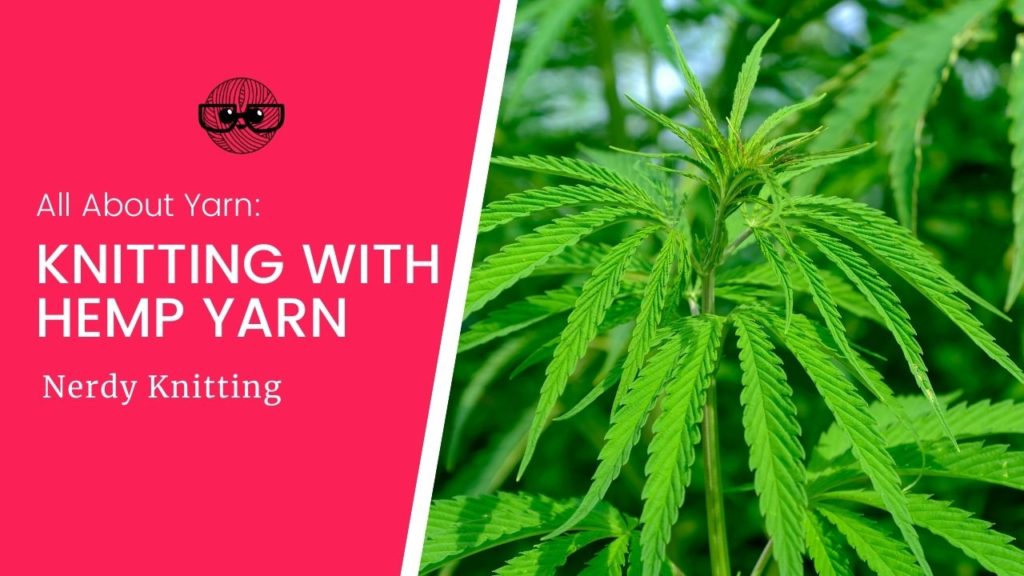Hemp yarn is a less-common relative of other plant fibers that are often used for knitting (the most common are cotton and linen). It has some disadvantages but can also be a great choice for certain projects (it’s fabulous for knit market bags and, when blended with cotton it makes great dishcloths).
There are a few things you should know about knitting with hemp yarn before you start. In this article we’ll look at a few common topics and questions knitters often have:
- Basic facts
- Properties of Hemp
- Knitting with Hemp Yarn
- Choosing Knitting Patterns
- Caring for Finished Projects
- Buying Hemp Yarn
Let’s take a closer look at each of these areas and then you’ll be prepared to give hemp yarn a try for your next knitting project.
Some links below are affiliate links. If you click through and make a purchase I may receive a small commission at no extra cost to you. See the disclosure policy for more information.
Basic Facts about Hemp
Yarn fibers can be roughly divided into four broad categories – animal fibers (like wool, silk, and alpaca), plant fibers (like cotton and linen), biosynthetic fibers (like rayon and bamboo), and synthetic fibers (like acrylic and nylon). Hemp fits in the plant fibers category because it comes from a naturally growing plant and it also doesn’t need heavy processing to turn the fibers into a useable yarn (like biosynthetic fibers need). It is processed in much the same way as linen is processed.
While many fragments of cotton and linen fabrics and textiles have been discovered, giving us a glimpse of life in the distant past, these are fewer and rarer the further we go back in time because of the nature of plant-based fibers to decompose with time. Even given this fact, there are examples of hemp fabrics dating as far back as 800 BC in Asia, where hemp fabric was common for everyday use. Along with fabric, it was also used to make rope, twine, sandals, shoes, and even shrouds.
It was also traditionally used for paper. According to The Principles of Knitting, hemp paper was used for the Gutenberg Bible and Thomas Jefferson wrote a draft of the Declaration of Independence on hemp paper as well. Benjamin Franklin also had a hemp paper making business.
Like linen, hemp goes through a long process to turn the plant into a useable fabric. The outer husk is soaked and then crushed so the inner fibers can be extracted. These fibers are then spun into useable yarn. Hemp is very easy to grow and doesn’t need any fertilizers or pesticides so it’s a good yarn choice for those with environmental concerns.
Sources: The Principles of Knitting – Hemp 101

The Properties of Hemp
Hemp yarn has some advantages and disadvantages that knitters need to know about before they start knitting. It’s a great yarn for market bags or placemats, and, if it’s blended with cotton or other absorbent plant fibers, it makes great dishcloths. But there are times you will want to avoid hemp.
Advantages of Hemp Yarn
While there are some drawbacks (discussed in the next section), hemp yarn does have some clear advantages that make it a good choice for some knitting projects. Here are some of the special advantages that hemp yarns can bring to your knitting projects:
- strong & durable
- good insulator
- absorbent
- mildew resistant
- non-pilling
- softens with washing
- absorbs dye well
- resists fading
Hemp is a good choice for market bags, placemats, and household goods or personal accessories because of its strength. It does soften with repeated washing (because of its similarity to linen yarns). And, if it’s combined with cotton, it’s a great combination that knits up into sturdy, absorbent dishcloths.
Disadvantages of Hemp Yarn
While hemp can be a good choice for certain projects, it has some drawbacks that you should be aware of before using hemp yarn for your next project. Hemp is:
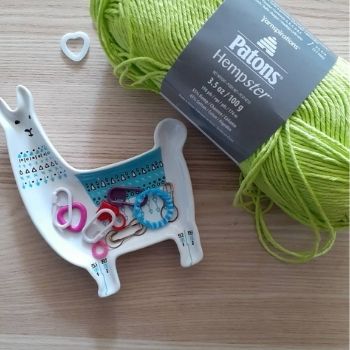
- coarse
- inelastic
- heavy
- stiff to work with
- rough on the hands
Because of its coarse, inelastic nature, it can be very rough on the hands while knitting. So it’s not a good choice for highly textured patterns. It works best in open work, lace, or simple Garter or Stockinette fabric. Even then, because of the coarse, stiff nature of hemp yarn, fabric will still be uneven.
For this reason, hemp will probably be blended with other fibers to reduce some of these disadvantages. It brings a good amount of strength to the blend as well as absorbency, mildew resistance, and other factors.
Hemp yarn make great market bags and home accessories, dishcloths, and even other projects, as long as the knitter is aware of the disadvantages when they are choosing their projects.
Get the Yarn Substitution Checklist
Fill in the form below to get a free copy of the Four Step Checklist for substituting yarn. Use it for your next knitting project!
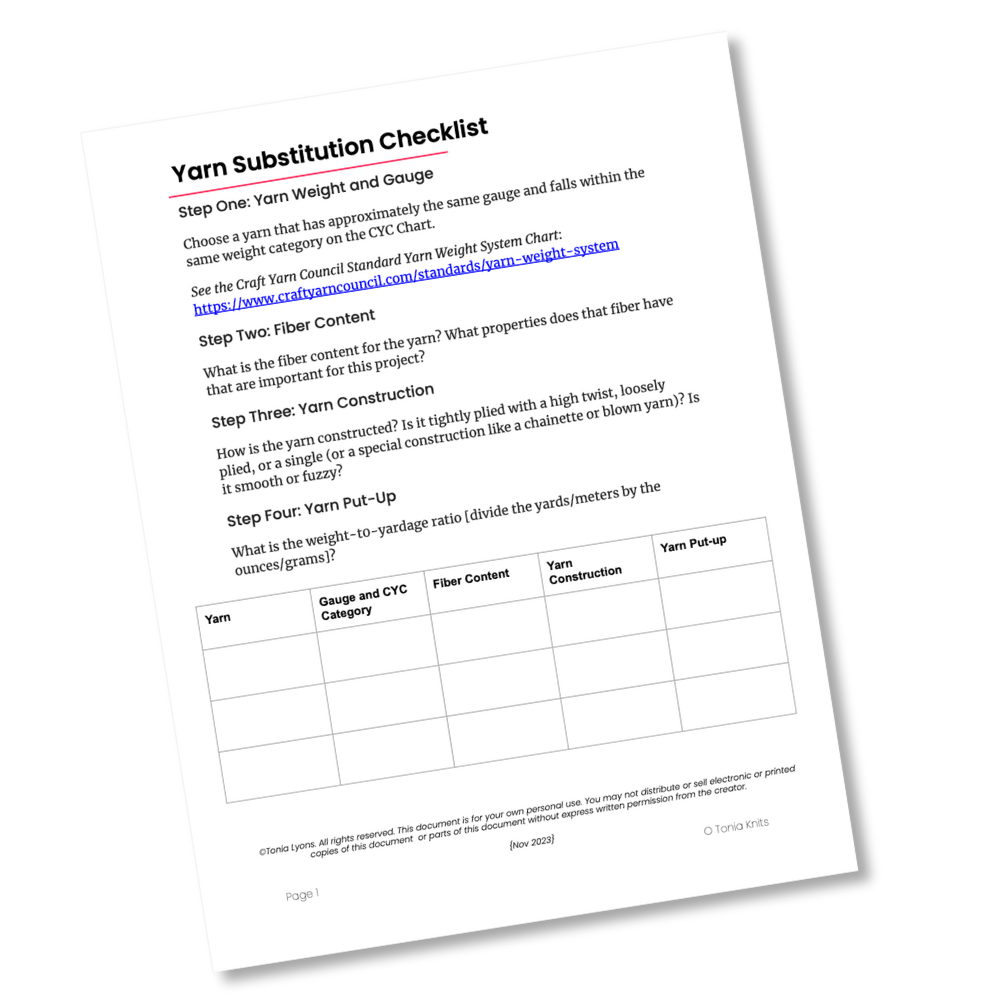
Knitting with Hemp Yarn
Pure hemp yarn is going to be hard on the hands. It is stiff and coarse and won’t produce an even fabric. Thankfully, things will even out somewhat when the fabric is washed (and it does soften with continued washing – like linen). Stick to plain Garter or Stockinette stitch or open lace designs with a loose gauge which will be easier on the hands and look better.
Hemp yarns (especially 100% hemp) also split easily, so you will want to pay attention to the yarn as you knit to ensure you’re not splitting plies as you knit.
If hemp is part of a blend (for example, plied with cotton or wool), this opens up a world of possibilities. It provides strength and durability to a wool blend. It provides strength, durability, and mildew resistance to a cotton blend that would be ideal for dishcloths.
Related: Knitting with Linen Yarn: Everything You Need to Know
Choosing Knitting Patterns for Hemp Yarn
As we’ve discussed in the previous section, hemp yarn has some clear advantages and disadvantages and you will want to keep these in mind when selecting an appropriate knitting pattern for your yarn. The easiest thing to do is to simply choose a pattern that used hemp yarn to design the pattern. But, as simple as this sounds, because hemp yarn is not often used, there aren’t that many patterns published with this type of yarn specifically in mind.
The first thing to think about is what this type of yarn is good for. Because it’s stiff and coarse, it’s not great for garments. The one exception would be really open and lacy summer tops (like this Cancun Boxy Lace Top) and only if you’re sure that the yarn will soften with repeated washing.
If you’re using 100% hemp, avoid anything highly textured because it will hard to knit and the coarse, stiff nature of hemp yarn doesn’t have great stitch definition. Stick to simple fabrics or openwork, eyelet, or lace designs.
Hemp yarn is a good choice in other instances. Market bags knit with hemp yarn are strong and will hold their shape. This also works in our favor for things like coasters and placemats. It also works well for knit dishcloths, especially when blended with cotton. Hemp is absorbent, mildew resistant, and strong, making it a good complement to cotton’s softness and absorbency.
It also works well when it’s blended with other fibers (plant fibers or wool) – and that opens up even more possibilities. If hemp is part of a blend, it’s a much safer option for hand knit garments. In a situation like that, it works well for summer tops, tanks, and tees where its strength can help the garment hold its shape.
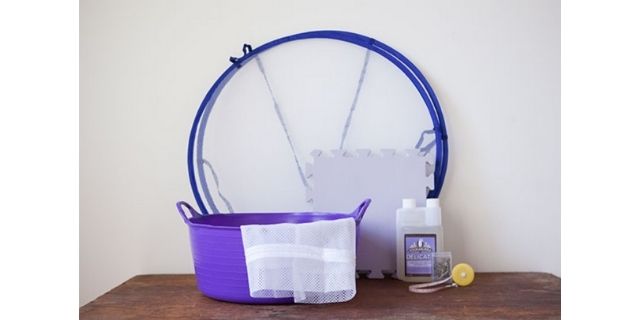
Caring for Hemp Knitting Projects
Hemp yarns and hemp blends are easy to care for. Many of them are machine washable and machine dry-able as well. Of course, you should always check the yarn label of your yarn for specific care instructions.
If it’s machine washable: Simply wash in the washing machine in cool water (gentle is always a good option for hand knitting) and, if the yarn label allows, toss it in the dryer. If it doesn’t, lay it flat to dry instead (and follow blocking instructions below if you want it to dry to specific measurements).
If it’s not machine washable: Wash by hand before laying the project flat to dry (and follow the blocking instructions below if there is lace involved or you want to ensure it dries to specific measurements).
How to Block Knitting Projects Knit in Hemp
Hemp knitting projects don’t need any special blocking techniques. (At its simplest, blocking is just caring for your hand knit garments.) If you follow the care instructions on the yarn label and it doesn’t produce the result you want – which may be the case if you knit an open or lace design that needs a little work to open up completely – wet blocking is a good choice.
Wet-blocking: After washing, and while the project is still wet, pin the project to its final shape and finished measurements on a blocking mat, being careful to stretch any lace or other openwork designs to showcase them.
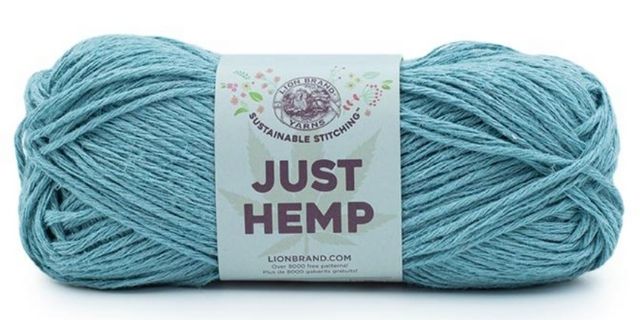
Buying Hemp Yarn
100% Hemp yarns are not common (I’ve linked a few that I found). You are more likely to find hemp blended with other fibers to reduce some of its drawbacks. When a yarn uses hemp it adds some strength to the yarn. This is why it’s commonly blended with cotton. Cotton is also inelastic but it isn’t strong and projects knit in cotton have a tendency to sag and droop with time. Adding hemp to a cotton yarn gives it some additional strength and makes those same projects less likely to sag and droop.
100% hemp yarns:
Here are a few hemp blends to try:
- Knit One Crochet Two Daisy (linen, silk & hemp blend)
- Cascade Yarns Eco+ Hemp (wool & hemp blend)
- Patons Hempster (hemp & cotton blend)
- Elsbeth Lavold Hempathy (cotton, hemp & modal blend)
- Lana Grossa Slow Wool Canapa (wool & hemp blend)
- Katia Boheme (cotton & hemp blend)
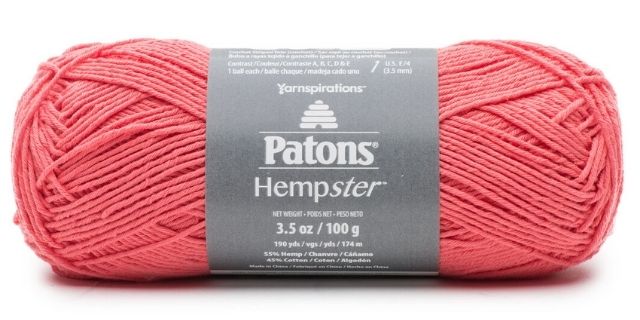
More Questions & Answers about Hemp Yarn
If you’re just looking for a quick answer to a specific question about hemp yarn, here’s a list of the commonly asked questions and quick answers to those questions.
What can you knit with hemp yarn?
Hemp is a strong, inelastic yarn that’s great for market bags and home accessories like placemats and coasters. It’s also great for other accessories like bags, lace headbands, and bead projects. When blended with cotton it makes great dishcloths.
How do you soften hemp yarn?
Like linen yarn, hemp yarn can be softened before knitting. Wind the yarn into a hank and soak in lukewarm water for thirty minutes, allow to dry, and wind the yarn into a ball.
Does hemp shrink when washed?
Like other natural fibers (like cotton), hemp yarn can shrink when it is washed in hot water and then put in the dryer. Check the yarn label for the best instructions for caring for your hemp knitting projects.
What is hemp yarn made out of?
Hemp yarn is derived from a plant in the cannabis family. The yarn is processed like linen yarn, where the plant is soaked and then crushed so the inner fibers can be extracted. These fibers are then spun into useable yarn and often blended with other fibers for yarns that can be used in knitting.
More About Yarns & Fibers
- The Knitter’s Book of Yarn by Clara Parkes (available at Amazon)
- Yarn Substitution Made Easy by Carol J. Sulcoski (available at Amazon)
- Knits from the Greenhouse by Cornelia Bartlette (available at Amazon)
- Yarn Garden: 30 Knits Using Plant-Based Fibers by J. Marsha Michler (available on Amazon)
Related Knitting Articles
- All About Knitting Bamboo Yarn: Everything You Need to Know
- What You Need to Know about Knitting with Cotton Yarn
- A Beginner’s Guide to Yarn Substitution
